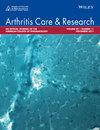回复关于生物或靶向合成抗风湿药物新使用者结核病筛查实践的意见:呼吁个体化方法
IF 3.7
2区 医学
Q1 RHEUMATOLOGY
引用次数: 0
摘要
我们主张在使用生物或靶向合成 DMARDs(b/tsDMARDs)之前普遍进行潜伏结核感染(LTBI)筛查。首先,尽管有关新型 b/tsDMARDs 的 LTBI 再激活风险的证据正在不断积累,但这些研究都是在已对患者进行过 LTBI 筛查和治疗的人群中进行的,这意味着再激活的真实风险很难通过目前的研究进行评估。其次,虽然有一些算法可以预测非流行性人群中活动性肺结核的风险,但这些模型使用的免疫抑制类别很广,LTBI 筛查的结果限制了它们在确定筛查对象方面的实用性。重要的是,仅根据人口统计学特征进行筛查是有局限性的。第三,医疗保险和医疗补助服务中心(Center for Medicare and Medicaid Services)的既定目标是实现患者零可预防伤害,而自 COVID 以来,美国的结核病发病率不断上升。免疫抑制是一个强有力的风险因素,这表明筛查应该普及。本文章由计算机程序翻译,如有差异,请以英文原文为准。
Reply.
求助全文
通过发布文献求助,成功后即可免费获取论文全文。
去求助
来源期刊

Arthritis Care & Research
RHEUMATOLOGY-
CiteScore
9.40
自引率
6.40%
发文量
368
审稿时长
3-6 weeks
期刊介绍:
Arthritis Care & Research, an official journal of the American College of Rheumatology and the Association of Rheumatology Health Professionals (a division of the College), is a peer-reviewed publication that publishes original research, review articles, and editorials that promote excellence in the clinical practice of rheumatology. Relevant to the care of individuals with rheumatic diseases, major topics are evidence-based practice studies, clinical problems, practice guidelines, educational, social, and public health issues, health economics, health care policy, and future trends in rheumatology practice.
 求助内容:
求助内容: 应助结果提醒方式:
应助结果提醒方式:


